|
|
|
Sort Order |
|
|
|
Items / Page
|
|
|
|
|
|
|
| Srl | Item |
| 1 |
ID:
098443
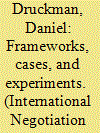

|
|
|
|
|
| Publication |
2010.
|
| Summary/Abstract |
A theory-oriented approach to teaching and training about negotiation is discussed in this article. Following the flow of a course taught on several continents, I emphasize the value of conceptualizing about the negotiating experience. This is done with concepts, metaphors, frameworks, and research findings summarized in the form of a set of narratives. A series of exercises bring the concepts to life. These include the difference between negotiating values and interests, designing scenarios, and enacting the negotiating functions of analyst, strategist, and designer. Students are also given an opportunity to perform as negotiators and observers in a complex multi-issue negotiation involving security issues similar to those discussed recently between the U.S. and Iraq. They are provided with a research experience that entails coding selected peace agreements for distributive and procedural justice as well as for the durability of those agreements. Lessons learned are generated in de-briefings of the exercises. They are also discussed in a final class where students' insights, gained from comparative case analyses, are organized by the framework introduced during earlier classes.
|
|
|
|
|
|
|
|
|
|
|
|
|
|
|
|
| 2 |
ID:
098442
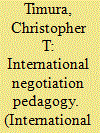

|
|
|
|
|
| Publication |
2010.
|
| Summary/Abstract |
This collection of articles on international negotiation pedagogy compares and contrasts a range of training methods and theories employed by scholars who teach international negotiation from different disciplinary backgrounds and in diverse institutional settings. Notwithstanding this variation, the contributors share a focus on enabling students to engage in negotiation and conflict analysis by teaching a set of core heuristics, to better understand interpersonal behavioral dynamics and learning certain interpersonal skills, and to practice negotiation and conflict analysis through the use of role plays and simulations. The contributors make different observations about the impact of students' personal knowledge and experiences on their ability to learn negotiation skills, and have developed different ways of incorporating student backgrounds in their approaches to negotiation training. The development of more complex simulations is one way instructors are beginning to leverage student knowledge and experience to achieve pedagogical goals.
|
|
|
|
|
|
|
|
|
|
|
|
|
|
|
|
| 3 |
ID:
098447
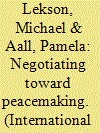

|
|
|
|
|
| Publication |
2010.
|
| Summary/Abstract |
This article outlines the approach of the United States Institute of Peace (USIP) to training in negotiation and associated skills. USIP has provided such training for over a decade to a wide array of international practitioners, both those who are in some way directly engaged in, or at least affected by, a conflict, and international third parties from outside the conflict zone. USIP concentrates in its negotiation training on building an understanding of the negotiating environment as well as on building specific negotiation strategies. In addition to skill-building, the training programs focus on developing an understanding of the nature and dynamics of conflict and of the overlapping and interlocking nature of actors, issues, and interests in a conflict situation. The article points out five elements of content that must be included to ensure a successful program, providing illustrative examples from actual workshops. These elements include helping participants to establish effective relationships with negotiating counterparts; presenting basic concepts; acquiring and improving skills; practicing through simulations; and working together on how best to apply these skills to the real world conflicts with which they are dealing. The two case studies describe training programs for Serbian and Albanian leaders in Kosovo, and for Iraqi civil servants.
|
|
|
|
|
|
|
|
|
|
|
|
|
|
|
|
| 4 |
ID:
098445
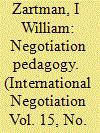

|
|
|
|
|
| Publication |
2010.
|
| Summary/Abstract |
Negotiation is less taught than might be expected in International Relations (IR) programs. Yet an upper-level university course is needed to address three audiences: future citizens, diplomats, and scholars. Since there is no single theory of negotiations, such a course needs to address the various conceptual approaches, grouped as Behavioral, Processual, Integrative, Structural, and Strategic. Conceptual presentations need to be supplemented with practitioners' testimonies, simulations, and case studies, the latter using participants' accounts as well as analyses. Games and a sample syllabus are presented.
|
|
|
|
|
|
|
|
|
|
|
|
|
|
|
|
| 5 |
ID:
098448
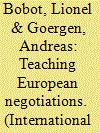

|
|
|
|
|
| Publication |
2010.
|
| Summary/Abstract |
The European Union is probably the most complex political and institutional decision-making structure known to humankind. Nowadays, scholars increasingly agree that no single theory can explain all the mechanisms at work in the system of EU governance and decision-making at all levels in any satisfactory way. Even for trained experts and specialists, the complexity of the EU machinery is extremely difficult to grasp. The extensive academic debate in this area is an indicator for both the sophistication of the scholarly discussion and the uncertainty of those who are trying to understand and explain the European integration project. For students who are just learning about the field, trying to untangle that complexity is even more challenging. The difficult task for teachers and instructors is finding ways to introduce students to the institutional framework and the related legislative processes of EU decision-making, and thereby help to facilitate their understanding of the nature of the Union. The purpose of this study is to suggest an alternative teaching method. The simulation "EU Chocolate Directive," can provide participants with the tools necessary to negotiate more effectively at the EU level.
|
|
|
|
|
|
|
|
|
|
|
|
|
|
|
|
| 6 |
ID:
098444
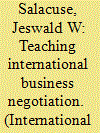

|
|
|
|
|
| Publication |
2010.
|
| Summary/Abstract |
The author has taught international business negotiation in a wide variety of university courses and executive training programs throughout the world during the last three decades. He has taught international business negotiation both as an end in itself and as a means to teach law, an approach that he calls "the law in the shadow of negotiation." This article examines three fundamental dimensions of that experience: pedagogical goals, course content and teaching methods. His principal pedagogical goals in international business negotiation courses have been three-fold: better negotiation analysis, improved negotiation skills, and increased international business knowledge. Depending on the time available, the content of his international business negotiation courses covers three broad areas: the fundamentals of conflict analysis and the negotiation process, basic themes in international negotiation, such as the importance of negotiation, preparation and the management of internal negotiations, and the special obstacles faced in international business negotiation, such as cultural differences among the parties, the actual or potential role of governments in the negotiation process, and challenges to the stability of negotiated agreements. The author's teaching relies heavily on experiential methods and materials, such as exercises, simulations and cases, although more didactic methods also have a role.
|
|
|
|
|
|
|
|
|
|
|
|
|
|
|
|
| 7 |
ID:
098446


|
|
|
|
|
| Publication |
2010.
|
| Summary/Abstract |
Despite the wealth of experience among simulation scholars, there is still little consensus on how to link gaming attributes to specific learning objectives. This article aims to contribute to this discussion and argues that specific simulation design can lead to reaching pre-defined learning objectives. The authors present a teaching project developed and executed for the Netherlands Defense Academy, how it was set up in 2005, and the way it evolved over time. The authors discuss how the methodology fits into the academic debate on the strengths of experiential learning. The simulation methodology used is rooted in experiential learning and typically supports standard learning goals and styles. When dealing with a specific target group, it is possible to pinpoint one specific, overarching learning objective. This allows trainers to link each individual aspect of the simulation design to that particular learning goal and, in turn, provides a valuable framework to develop, run and evaluate simulation exercises. The authors discuss how two innovative elements in simulating gaming can help to make such an approach work: combining closed and open scenarios, and new communication software that allows for continuous supervision during the game. The conclusions discuss how students respond to the challenges during the game and what the data from debriefings tells us about the methodology's learning appeal for a military target group.
|
|
|
|
|
|
|
|
|
|
|
|
|
|
|
|
|
|
|
|
|